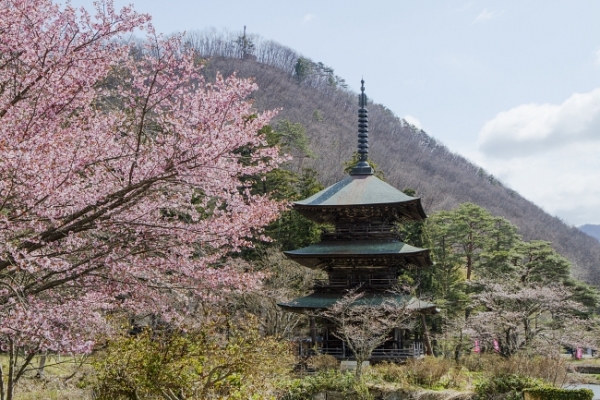Take a trip around Takahata: Its history and heritage

While most people are familiar with the major cities in Japan like Tokyo, Osaka, and Kyoto, there is a wealth of lesser-known places in Japan that also deserve your attention! One of them is the town of Takahata (高畠町 Takahata-machi) in Yamagata (山形県 Yamagata-ken).
Mention Yamagata, and most people would immediately think of Risshakuji (立石寺), better known as Yamadera (山寺) and famed for its climb of more than a thousand steps to the summit; for others, the Three Mountains of Dewa (出羽三山 Dewa Sanzan)—Mount Haguro (羽黒山 Haguro-san), Mount Gassan (月山 Gassan), and Mount Yudono (湯殿山 Yudono-san)—might spring to mind. While these (and many others) are all tourist spots famous in their own right, Takahata boasts a wide variety of attractions, both natural and man-made, guaranteed to satisfy all who visit. Continue scrolling down to find out more about what awaits you in Takahata as I take you on a virtual journey over two articles!
An introduction to Takahata

A view of Takahata Town from Mount Bishamon. (Image credit: 高畠町観光協会)
Takahata is a small town situated in the southern part of Yamagata, in the Okitama area (置賜地方 Okitama-chihō) of the prefecture. Being surrounded by mountains such as the Ōu Mountain Range (奥羽山脈 Ōu-sanmyaku), as well as having major waterways like the Mogami River (最上川 Mogami-gawa) flowing through it, Takahata is blessed with a mild climate and abundant precipitation throughout the year, making it suitable for agriculture. In fact, agriculture is one of the main industries of Takahata, with its famed produce like Delaware grapes and La France pears found in supermarkets nationwide during their respective seasons.
That it is surrounded by mountain ranges, though, means that summers can get fairly hot, and winters pretty cold, as well as snowy—when I was in Takahata a few years back in December, the snow that fell was heavy and wet, unlike the drier, more powdery snow that falls in more inland areas in other parts of Japan. It was quite a challenge walking through all that snow just to visit some of their attractions!

Takahata Winery, before I entered and after I exited. It was tough walking back to the station in all that snow….. (Image credit: Kevin Koh)
Once a castle town back during the Edo Period (江戸時代 Edo-jidai), part of the area which makes up Takahata Town today became Takahata Village (高畑村 Takahata-mura) in 1889, 20 years after the start of the Meiji Period (明治時代 Meiji-jidai) and the establishment of the municipal system. It became present-day Takahata Town in 1955 after mergers with other municipalities and a few name changes—today, Takahata Town, despite having an area less than a quarter that of Singapore’s, has a population of only 23,000, or 0.3% that of Singapore’s!

A view of Takahata Station in its entirety. (Image credit: Yamagata Prefectural Government)
With the opening of the Yamagata Shinkansen (山形新幹線) in 1992, access to Takahata from Tokyo became much easier, as there were now direct trains—previously, in order to get to Takahata, a transfer to the Ōu Main Line (奥羽本線 Ōu-honsen) had to be done at Fukushima Station (福島駅 Fukushima-eki).
The gateway to Takahata Town is JR Takahata Station (高畠駅 Takahata-eki), previously known as Nukanome Station (糠ノ目駅 Nukanome-eki) before it got renamed in 1991. Its visually arresting fairy tale-like castle motif makes sense when you consider that Takahata is the birth town of Hamada Hirosuke (浜田広介), a famed writer of children’s rhymes and stories, and frequently referred to as the Hans Christen Andersen of Japan! With all that awaits you in Takahata, entering the town via such a unique station is indeed akin to stepping into a magical world!
Sites of history and heritage in Takahata

The entrance to Uriwari Sekitei Kōen. (Image credit: photoAC)
While fruits may be one of Takahata’s most well-known products nowadays, there is another item it produces that has been popular for a long time—stone, specifically a kind called Takahata stone (高畠石 Takahata-ishi). Formed from the sedimentation of volcanic ash spewed during eruptions in the past, the stone contains numerous small bubbles within, and is prized for its warm, yellow colour.

The walls of Takahata stone at Uriwari Sekitei Kōen. (Image credit: 山形県公式観光サイト)
Stone mining started during the Taishō Period (大正時代 Taishō-jidai), and reached its peak in 1954 in Takahata, with numerous quarries all around. In fact, so popular and well-regarded was Takahata stone, that the name it was sold by differs according to where it was mined, not unlike how tuna in Japan fetches a premium when it is labelled as coming from certain fishing grounds!

It feels like the stone walls are closing in on you… (Image credit: 山形県公式観光サイト)
One quarry that is still in operation today and can be explored is the Uriwari Sekitei Kōen (瓜割石庭公園). So named because of an old tale in which melons cooled in the water from the quarry split into two because of how cold the water was, a step into the quarry reveals a space surrounded by walls of Takahata stone, giving it an otherworldly field. The site was also formerly used as an outdoor concert hall, and is nowadays used as a venue for imo-ni (芋煮), Yamagata’s soul food of beef and taros stewed in soy sauce.
For those who would like to experience the history of Takahata up close, this quarry is not to be missed!
Uriwari Sekitei Kōen (瓜割石庭公園)
Address: Akutsu, Takahata, Higashi-Okitama-gun, Yamagata 992-0302
Nearest station: JR Takahata Station (JR高畠駅)
Access: 15-minute drive from Takahata Station
Tel: +81-23-852-5433
Writer’s note: The telephone number given above is for the Takahata Roadside Station. The park can be visited between spring and autumn—in winter, the snow in and around the area is not cleared, and the park cannot be accessed.

The old Takahata Station building, built with Takahata stone. (Image credit: contri / CC BY-SA 2.0)
Takahata stone can be used in a variety of ways, and in the past, it was used as a foundation for houses, as well as gravestones, in the Edo period. Although one of the best ways to experience Takahata stone up close is through a visit to the aforementioned quarry, there is also a very special building in Takahata Town that is built entirely using Takahata stone—the station house of the former Takahata Station (旧高畠駅 Kyū-Takahata-eki).
Even though JR Takahata Station is today the only railway station in Takahata Town, back in the past, there used to be a private line running through the town. Called the Takahata Line (高畠線Takahata-sen) and operated by Yamagata Kōtsū (山形交通), it connected Nukanome Station (the former name for JR Takahata Station) with Nījuku Station (二井宿駅 Nījuku-eki). Built as a means of transporting the silk, agricultural produce, and other industrial goods produced in Takahata Town, the line was unfortunately discontinued in 1974, after trucks became the main means of transporting goods.

One of the preserved trains that previously ran on the Takahata Line on display behind the old station building. (Image credit: contri / CC BY-SA 2.0)
Though most of the rails and old station buildings related to the Takahata Line have been removed, the former Takahata Station building has fortunately been preserved in all of its former glory. Along with the building, a few trains that were used on the Takahata Line have also been preserved at the back of the building, making it a mini-museum of sorts for the Takahata Line. A visit to the former Takahata Station will take you back into time, making this a must-visit for history buffs and rail aficionados alike!
Former Takahata Station (旧高畠駅)
Address: 1568 Takahata, Higashi-Okitama-gun, Yamagata 992-0351
Nearest station: JR Takahata Station (JR高畠駅)
Access: 10-minute drive from Takahata Station
Tel: +81-23-852-1111
Writer’s Note: The telephone number given above is for the Cultural Affairs Division of the Takahata Town Office.
Taste the fresh produce of Takahata!

Some of the sake and wines from Takahata. (Image credit: Kevin Koh)
As mentioned, farming is one of the main sources of revenue in Takahata. With people being more mindful about the food that they eat today, organic farming has also taken root in Takahata. In fact, the organic movement in Takahata began all the way back in the early 1970s, when young farmers sceptical of chemical fertilisers and the rapid modernization of farming techniques banded together to form an organic farming group.
Today, Takahata boasts the greatest land area devoted to organic farming in all of Yamagata, and it is further proving its commitment to organic farming through its intention to further improve and expand organic farming in the town in a plan laid out last March, in accordance with the SDGs laid out by the United Nations.
In a nod to this movement, geographical indications (GIs) are now affixed to produce from Yamagata that meets stringent requirements, giving consumers peace of mind and confidence when they purchase products from Yamagata. In addition to fruits and vegetables, many brands hailing from Takahata have also been given the GI Yamagata status—for instance, sake from Yonetsuru Brewery (米鶴酒造 Yonetsuru Shuzō) and wines from Takahata Winery (高畠ワイナリー) have also been awarded this standard in 2016 and 2021 respectively. These products, as well as many others, can be purchased at online retailer SUPAFRESH! They are currently holding a Takahata fair (very aptly called “Terrific Takahata”), so do have a look at some of the products from Takahata available for purchase! I have personally sampled some of the wines, sakes and dips, and they are all excellent and well worth your buck! An interesting choice is the sparkling rose from Yonetsuru Brewery—deriving its pink hue from the yeast used in the brewing process, the sake is sweet with a slight tinge of sourness to it, not unlike ripe strawberries and red grapes, and is an excellent drink that goes well with all kinds of food!

The sparkling rose from Yonetsuru Brewery enjoyed in two ways, on its own and as a sake sangria with local fruits. Kanpai! (Image credit: Kevin Koh)
Alternatively, for those of you who wish to sample these products before purchasing them, you might be pleased to know that a few restaurants, in collaboration with Takahata Town, are holding a fair where you can taste some of the best of what Takahata has to offer! One such restaurant currently collaborating with Takahata Town is Willow, a contemporary Asian dining space that just opened in mid-February. Showcasing ingredients from Japan presented in ways that bring out the best of their flavour, the menu changes regularly based on what chef Nicholas Tam is able to procure, so you can be assured that you are being served only the freshest and the very best whenever you dine there! Do visit the webpage, or call the number below, to secure your reservations.
Willow
Address: 39 Hongkong Street, Singapore 059678
Nearest MRT station: Clarke Quay (NE5)
Access: 6-minute walk from Clarke Quay Station
Opening hours: 12pm—4pm (lunch), 6pm—11pm (dinner), (Tuesday–Saturday) (Closed on Sundays and Mondays)
Tel: +65-8885-4667
In addition, a survey campaign about food and drinks from Takahata is also being conducted at the same time—stand a chance to win attractive prizes simply by filling up an online form and answering a few questions!
Land of paradise
Takahata is nicknamed “mahoroba no sato” (まほろばの里), or “land of paradise”, and for good reason—with its bountiful produce, beautiful scenery and rich history, I cannot imagine a better place for travellers to explore and discover something new about Japan!
Stay tuned for Part 2 of the article, where I introduce many other things one can enjoy in Takahata, ranging from festivals to onsens to food, as well as how to get to Takahata!
Header image credit: 山形県公式観光サイト





